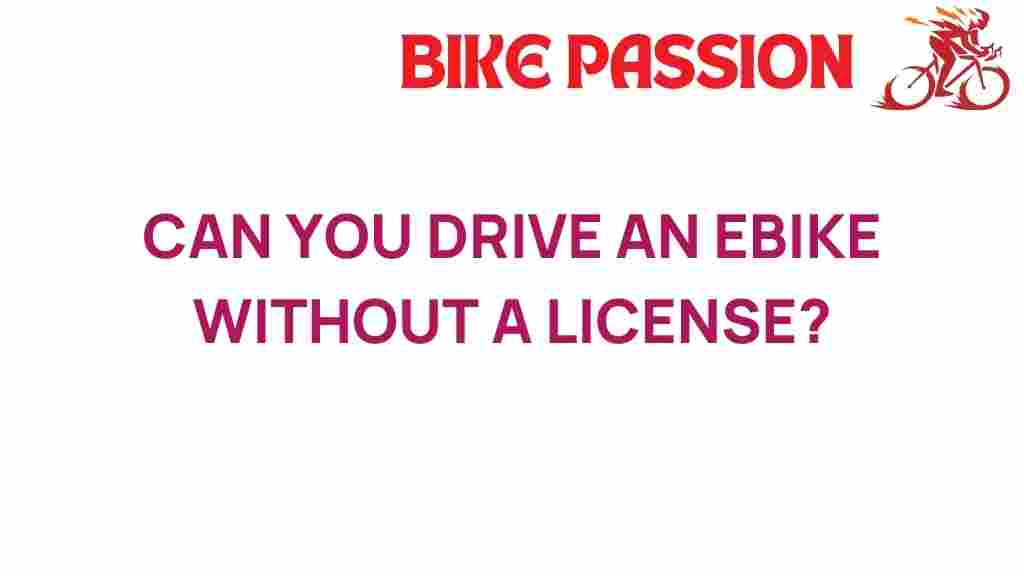The Surprising Truth: Can You Drive an E-Bike Without a License?
As electric bikes, or e-bikes, gain popularity as a sustainable and efficient mode of transportation, many potential riders wonder about the legal requirements to operate one. Are licenses necessary? What are the regulations governing e-bike use? In this article, we will unravel the truth behind riding laws, compliance, and safety considerations concerning e-bikes. By the end, you’ll understand whether you can hop on an electric bike without a license and how to enjoy your adventure responsibly.
Understanding E-Bikes and Their Popularity
E-bikes are equipped with an electric motor that assists with pedaling, making them an appealing option for commuters and adventure seekers alike. They come in various styles, from sleek city bikes to rugged mountain variants, allowing riders to choose based on their needs. The surge in popularity is attributed to several factors:
- Environmental benefits: E-bikes produce zero emissions, making them a greener alternative to cars.
- Cost-effectiveness: Operating an e-bike is significantly cheaper than maintaining a car.
- Health benefits: Riders can enjoy physical activity while benefiting from motor assistance, making it easier to tackle hills and longer distances.
- Convenience: E-bikes can navigate through traffic and require less parking space than traditional vehicles.
Regulations Surrounding E-Bikes
When it comes to operating an e-bike, regulations vary significantly by location. Understanding these regulations is crucial for ensuring compliance and safety. Here are some general guidelines concerning e-bikes:
- Classification: E-bikes are often classified into three categories:
- Class 1: Pedal-assist only, with a maximum assist speed of 20 mph.
- Class 2: Throttle-assisted, also capped at 20 mph.
- Class 3: Pedal-assist, with a maximum speed of 28 mph.
- Age restrictions: Some states require riders to be a certain age (usually 16 or older) to operate an e-bike.
- Helmet laws: While not universally mandated, wearing a helmet is strongly recommended for safety.
- Where to ride: Regulations may dictate where e-bikes can be ridden, such as bike paths, roads, or restricted areas.
Do You Need a License to Ride an E-Bike?
One of the most common questions among prospective e-bike riders is whether a license is required. The answer largely depends on your location and the e-bike classification. In most cases:
- Class 1 and Class 2 e-bikes: Typically, you do not need a license to ride these types of e-bikes. They are treated similarly to regular bicycles.
- Class 3 e-bikes: Some jurisdictions may require a license or registration to operate Class 3 e-bikes, especially if they exceed 20 mph.
It’s essential to check local laws to ensure compliance. For specific regulations in your area, you can visit National Bike Packing Regulations.
Step-by-Step Guide to Riding an E-Bike Legally
If you’re eager to explore the world on your e-bike, follow these steps to ensure you’re riding legally and safely:
- Research local laws: Before riding, familiarize yourself with the e-bike regulations in your area.
- Choose the right e-bike: Select an e-bike that fits within the legal classifications and your riding needs.
- Wear a helmet: Always wear a helmet, regardless of age or local laws, to ensure your safety.
- Register if necessary: If you’re riding a Class 3 e-bike, check if registration or a license is required.
- Follow traffic laws: Obey all traffic signs and signals, just as you would when driving a car.
Safety Tips for E-Bike Riders
Safety should always be a top priority when riding an e-bike. Here are some essential tips to keep in mind:
- Stay visible: Use lights and reflective gear, especially when riding at night.
- Be aware of your surroundings: Stay alert to traffic, pedestrians, and road conditions.
- Maintain your e-bike: Regularly check the brakes, tires, and battery to ensure everything is functioning correctly.
- Ride at a safe speed: Know your limits and the speed limits in your area.
- Take a safety course: Consider completing an e-bike safety course to enhance your riding skills.
Troubleshooting Common E-Bike Issues
Even the most reliable e-bikes can encounter issues. Here are some common problems and how to address them:
- Motor not working: Check the battery charge and connections. If the battery is low, recharge it fully.
- Brakes squeaking: Inspect the brake pads and ensure they are not worn out. Adjust or replace them as needed.
- Flat tires: Carry a puncture repair kit and learn how to change a tire on your e-bike.
- Battery draining quickly: Ensure you’re not using excessive power settings and that the battery is maintained properly.
Conclusion
The question of whether you can drive an e-bike without a license is largely dependent on your location and the type of e-bike you intend to ride. Generally, for Class 1 and Class 2 e-bikes, a license is not necessary, making it easy for anyone to enjoy the adventure that e-bikes offer.
However, it’s vital to stay informed about local regulations to ensure legal compliance and prioritize safety while riding. E-bikes can enhance your transportation options, offering a fun and eco-friendly way to explore your surroundings. By following the guidelines and tips outlined in this article, you can embark on your e-bike journey with confidence and peace of mind.
If you’re curious to learn more about e-bike adventures, check out our comprehensive guide on E-Bike Riding Laws for more information!
This article is in the category Tech and created by BikePassion Team
